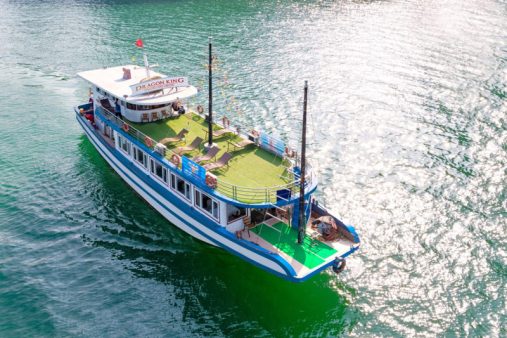Scattered across the picturesque central coast and plains of Vietnam, lie the captivating ruins of the ancient Champa kingdom. Flourishing for over a millennium, from the early centuries of the first millennium CE, the Cham civilization thrived in the lush, fertile valleys and sheltered bays of Central Vietnam. Among these remarkable remnants, the ancient citadel of Vijaya, located near present-day Quy Nhon, served as the esteemed capital of the Cham kingdom for 500 years, from the late 10th century until 1471 when it was eventually conquered by the Vietnamese from the north.

The Cham civilization, deeply influenced by Indian culture, embraced Hinduism as its predominant religion for the majority of its existence. Today, the awe-inspiring ruins of Cham towers, temples, shrines, and cities stand as powerful testaments to the rich historical heritage of what is now Vietnam. Embarking on a rewarding day trip from Quy Nhon, located on the central coast, visitors can explore the remarkable Cham towers and the evocative remains of Vijaya. In many ways, this experience proves to be more poignant than visiting the renowned ruins of My Son near Hoi An. While the latter attracts throngs of visitors daily, the sites near Quy Nhon exude tranquility and are seldom explored. Here, a profound sense of history envelops the surroundings, surpassing that found in most other historical sites in Vietnam or even in Europe.
Immerse yourself in the captivating allure of the Cham Towers & Ancient Citadel of Vijaya, where Vietnam’s remarkable past comes alive amidst breathtaking landscapes and the echoes of a bygone era.
Quy Nhon, with its proximity to several remarkable Cham sites, offers an excellent opportunity to delve into the rich heritage of the Champa kingdom. In this comprehensive guide, we will focus on four prominent Cham sites that can be conveniently visited in a single day. It’s important to note that the region is home to many other captivating Cham sites, and for a deeper understanding of the historical context, a visit to the Binh Dinh Museum in Quy Nhon is highly recommended.
Embark on a captivating journey as we explore these four remarkable Cham sites near Quy Nhon, each unveiling unique insights into the rich cultural tapestry of the Champa civilization. Discover the intricate architecture, ornate sculptures, and the fascinating stories behind these ancient relics. Immerse yourself in the historical context and marvel at the preservation of these cherished remnants.
With Quy Nhon as your base, prepare for an enlightening adventure as we uncover the hidden gems of Cham heritage, offering a glimpse into the vibrant tapestry of Vietnam’s past.
Sitemap
1. Twin Cham Towers (Thap Doi): An Exquisite Blend of History and Modernity

Discover Twin Cham Towers, a remarkable Cham site located just a short 5-minute drive northwest of Quy Nhon’s bustling downtown. Nestled within a serene park, these two towers, dating back to the 12th century, offer a captivating glimpse into the intersection of ancient heritage and contemporary Vietnam.
As you approach the site, the contrast between the intricate ruins and the vibrant buzz of modern traffic is a striking representation of the dynamic nature of 21st century Vietnam. The towers stand amidst a backdrop of slender coconut palms and lush tropical foliage, their architectural elegance mirrored in the surrounding natural beauty.

Ascending 20 meters skyward, the towers resemble magnificent red brick chimneys, adorned with arching forms and delicate floral motifs. Step inside and immerse yourself in the historical ambiance as you explore the interiors that open up to the heavens above.
Twin Cham Towers, being easily accessible, attracts a significant number of visitors and has become a popular spot for Vietnamese teenagers seeking the perfect selfie. To make the most of your visit, we recommend arriving early in the morning to enjoy the tranquility and serene atmosphere. Entrance to this mesmerizing site is priced at 10,000vnd.
Prepare to be captivated by the enchanting blend of history and contemporary life at Twin Cham Towers, where the past seamlessly intertwines with the present, creating a truly unforgettable experience.
2. Banh It Towers: A Hidden Gem of Tranquility and Cultural Significance

Nestled in plain sight, the Banh It Towers are a well-kept secret, often overlooked despite their easy accessibility and prominent location along Highway QL1A. Meticulously restored to their former glory, these four Cham towers exude an awe-inspiring presence as they proudly perch atop a picturesque hill. Here, serenity reigns supreme, with only the gentle flutter of butterflies and the caress of the wind to accompany you. Inside the towers, the haunting echoes of bat calls reverberate off the ancient red-brick walls.
Throughout history, the Cham Kingdom gradually retreated southward due to military pressures from the north and the relentless advances of the Khmer Angkor Kingdom from the west. Consequently, the Cham towers in Binh Dinh Province, such as those at Banh It, were constructed at a later period compared to their counterparts in Quang Nam Province to the north. Dating back to the 12th and 13th centuries, during the Cham capital’s relocation to Vijaya after the fall of Indrapura near Danang, the Banh It towers stand as proud testaments to this enduring civilization.
Perched atop a breezy hill, the Banh It towers offer panoramic vistas of the lush flood plains of the Thi Nai River, with the majestic Truong Son Mountains to the west and the sparkling ocean to the east. The site’s choice as a place of worship becomes evident, as the breathtaking surroundings provide a serene backdrop for spiritual contemplation. Throughout the ages, this sacred land has retained its hallowed essence, with subsequent inhabitants embracing its sanctity long after the Cham and their venerated Hindu deities faded into history. At the base of the hill, a Buddhist monastery peacefully resides, while a scattering of graves adorns the lower slopes, further attesting to the site’s enduring significance.
Immerse yourself in the captivating aura of Banh It Towers, allowing ample time to soak up the enchanting atmosphere and reflect upon the deep-rooted cultural heritage it embodies. Admission to this sacred sanctuary is priced at 10,000vnd, welcoming you to delve into a world where tranquility, spirituality, and natural beauty intertwine harmoniously.
3. Vijaya Citadel & Canh Tien Tower

Vijaya, known also as Cha Ban and Do Ban, is a place steeped in history, despite the scarcity of visible remnants. As the Cham capital from the 11th to the 15th centuries, Vijaya flourished as a prosperous and wealthy center. However, its legacy is one of frequent sieges, sackings, and bloody conflicts. Over the centuries, it witnessed the rise and fall of various dynasties, with the Khmer and Vietnamese armies vying for control. The citadel endured, albeit under different names and ruling powers, until at least the early 19th century. In 1471, Emperor Le Thanh Ton claimed victory over Vijaya, resulting in the loss of approximately 60,000 Cham lives. Subsequently, during the Tay Son Rebellion, Vijaya was rebuilt as Hoang De Citadel, serving as the stronghold of the Tay Son Dynasty in central Vietnam. However, its reign was short-lived, as Hoang De fell to Nguyen Anh, later known as Emperor Gia Long, the first emperor of the Nguyen Dynasty. Today, little remains of the once majestic citadel. While some sections of the original city wall stand, much of it has been meticulously restored. Unearthed artifacts provide glimpses into the original Cham structures, yet the majority of the visible structures date back to the 19th-century Nguyen Dynasty. Despite its poignant state of existence, Vijaya/Hoang De maintains an atmospheric allure, seemingly forgotten amidst the surrounding farmland, with the Reunification Express train passing by multiple times a day, airplanes overhead en route to Phu Cat Airport, and cows grazing beside stone dragons. Farmers pedal silently through the area, adding to the quietude. This site witnessed significant historical shifts in what is now Vietnam, yet it garners little attention.

Just minutes away, Canh Tien Tower stands proudly on a gentle rise behind the citadel. Although heavily restored, the tower’s ornate decorations pay homage to the lush tropical foliage that characterizes lowland Vietnam. Like all Cham towers in Vietnam, Canh Tien seamlessly blends with its natural environment, exuding a harmonious yet commanding presence. Estimated to be from the 13th to 14th centuries, Canh Tien Tower grants visitors an entry into the historical tapestry of Binh Dinh. Admission is available for a nominal fee of 10,000vnd, although the ticket kiosk may occasionally be unmanned.
Explore the remnants of Vijaya Citadel and behold the majesty of Canh Tien Tower, where the whispers of the past intertwine with the present. Immerse yourself in the profound stories and architectural wonders that unfold within these hallowed grounds.
4. Phu Loc Tower

Among the Cham loop, the final tower beckons, a gem often overlooked but brimming with allure. Traveling north from Vijaya, a narrow paved lane veers off Highway 1, guiding you through a rural landscape that evokes a medieval ambiance. While the specifics may have changed over time, the atmosphere remains steadfast—tranquil, hushed, and unhurried beneath the midday sun. A group of sinewy, bare-torsoed octogenarians seeks shade beneath tamarind trees, marking the site of an event from the 18th century Tay Son Rebellion (the intricacies eluded my comprehension).
They graciously offer directions to the Cham tower, whose ruins atop the hill intermittently grace the roadside before vanishing from sight. The lanes narrow further, passing sun-drenched haystacks and languidly grazing tethered oxen. Eventually, the paved path gives way to a dirt road, weaving through a village cemetery under the gentle rustle of eucalyptus leaves, leading to the foot of a hill.
Disembarking and venturing along a steep, narrow trail where arid bushes occasionally brush against your bare arms, you emerge into a grassy clearing. Weathered stone steps ascend to Phu Loc Tower, perched resolutely atop the hill, blending seamlessly with the natural landscape, impervious to the passage of time. Within the clearing, the tower casts a welcoming shadow, inviting you to rest and marvel at the vista unfolding over the plains, with the ancient capital of Vijaya and Canh Tien Tower clearly visible to the south. Imagination effortlessly reconstructs the Champa of the 13th century, as if viewed through the lens of history from this very hill. The tower itself stands imposing and weathered, a testament to its endurance. Accompanied solely by goats, cows, and regrettably, litter, you can explore its grandeur without any admission fee.






